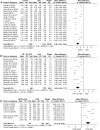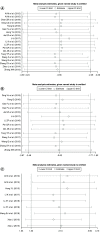Serum thymidine kinase 1 protein concentration for predicting early progression and monitoring the response to TACE in hepatocellular carcinomas: a network meta-analysis
- PMID: 34258026
- PMCID: PMC8256325
- DOI: 10.2144/fsoa-2021-0016
Serum thymidine kinase 1 protein concentration for predicting early progression and monitoring the response to TACE in hepatocellular carcinomas: a network meta-analysis
Abstract
Aim: A meta-analysis was conducted to evaluate the clinical significance of serum thymidine kinase 1 protein concentration (STK1p) in distinguishing between hepatocellular carcinomas (HCC) and non-HCC for predicting early progression and monitoring the response to transarterial chemoembolization in HCC.
Materials & methods: A total of 24 eligible studies were included, containing 1849 HCC patients and 1069 healthy subjects.
Results: The STK1p level significantly increased from normal controls to benign/pre-HCC and HCC (p < 0.0001). STK1p also increased significantly in sub-malignant groups: control being the lowest, followed consecutively by hepatic hemangioma, hepatitis B virus infection and hepatic cirrhosis (p < 0.05). After 1 month of transarterial chemoembolization treatment, STK1p level declined significantly, by 44.4% (p < 0.0001).
Conclusion: STK1p is a useful prognostic biomarker in HCC.
Keywords: HCC; NMA; STK1p; TACE; TK1; pre-HCC.
© 2021 Sven Skog.
Conflict of interest statement
Financial & competing interests disclosure J Zhou is the owner the company that produces the biomarker TK1 used in this meta-analysis. The authors have no other relevant affiliations or financial involvement with any organization or entity with a financial interest in or financial conflict with the subject matter or materials discussed in the manuscript apart from those disclosed. No writing assistance was utilized in the production of this manuscript.
Figures




References
-
- Ferlay J, Soerjomataram I, Siegel RL, Torre LA, Jemal A. Global cancer statistics 2018: GLOBOCAN estimates of incidence and mortality worldwide for 36 cancers in 185, countries. CA Cancer J. Clin. 68(6), 394–424 (2018). - PubMed
-
- Tsochatzis EA, Bosch J, Burroughs AK. Liver cirrhosis. Lancet 383(9930), 1749–1761 (2014). - PubMed
-
- Krishan S, Dhiman RK, Kalra N et al. Joint consensus statement of the Indian National Association for study of the liver and indian radiological and imaging association for the diagnosis and imaging of hepatocellular carcinoma incorporating liver imaging reporting and data system. J. Clin. Exp. Hepatol. 9(5), 625–651 (2019). - PMC - PubMed
LinkOut - more resources
Full Text Sources
Miscellaneous
